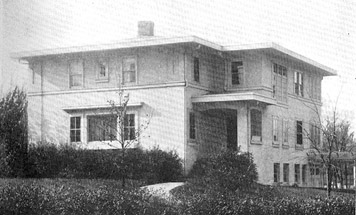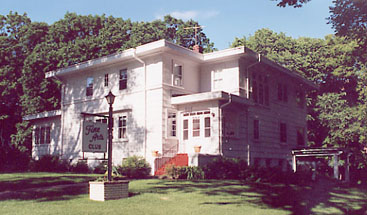Watson Hall

The City of Fargo lists the home at 601 4th Street S., as being built in 1916. It was likely built for John J. Feckler, Vice-President and Secretary of Pioneer Life Insurance Co. Within a year, the Feckler family had moved to California. On April 3, 1917, Lincoln National Life Insurance Company took over Pioneer Life Insurance Co. in a consolidation. Likely it was Mr. Feckler’s connection with Pioneer Life Insurance that prompted the home to become the Fargo headquarters handling the company’s northwestern business. Sometime in 1920, it was decided that Lincoln National Life Insurance Co. moved their offices to Minneapolis.
The Fargo College became interested in the house for use as home to the Fargo College Conservatory of Music. At the time the Conservatory of Music was using the Stone Piano Company hall, 613 1st Avenue N. in downtown Fargo. The college desired to move the Conservatory closer to the campus. So when the opportunity arose, they put into motion the purchase of the house. This took place on September 20, 1920, and by November 15th, the Fargo College Conservatory of Music had moved into the building. At the Fargo College executive committee meeting held December 23, 1920, Lizzie Watson approached the board members about contributing the $25,000, to pay for the building, in memory of her husband, John S. Watson. Mr. Watson, a prominent Fargo attorney with the firm Watson, Young & Conmy, had died in November 1919.
There were several stipulations that Mrs. Watson put in place:
1st: The property would at all times in the future, be used for College purposes, by Fargo College, or its successors in educational work. 2nd: No encumbrance would at any time be place upon the property, and the grantee would not permit liens of any kind to accrue against the property. All taxes and legally imposed assessments would be paid by the grantee before they become delinquent. 3rd: The property would be named in honor of her husband, and bear that name into the future. 4th: That adequate fire insurance would at all times be maintained on the building. And 5th: If the college failed to keep and perform any of the conditions, the title would immediately revert back to Mrs. Watson, her heirs, or successors.
The donation was accepted, but it came at a troubling time for Fargo College. They had mismanaged their budget, and were deep in the red. World War I had cut the college enrollment, and an increase in overhead expenses, forced the college to borrow money which could not be paid back. It was decided to suspend classes on June 22, 1922, until the college could raise enough money to reopen. The exception was the Conservatory, which continued on due to “its splendid standards and very considerable advertising value” to the college. The Fargo College continued their fundraising efforts, until October 24, 1929, when the stock market crashed. At that point all attempts to save the college ended, and it closed for good. Per Lizzy Watson’s stipulations, the home reverted back to her possession.
For years the Fine Arts Club had desired a permanent club home. In stepped in Mrs. Watson, who had been a club woman for many years and was keenly interested in the women’s club movement. She brought forward the idea of donating the former Watson Hall to the Fine Arts Club, and on November 5, 1930; at the Fine Arts Club general meeting, the gift was formally accepted. The agreement was basically the same as her previous stipulations to the Fargo College.
The home was remodeled, redecorated and refurbished to meet the club’s needs. An in 1937-1938, a south stage addition was added to the house. This addition was designed by architect, Knut Henning.
The house had one downfall and that was its location on low ground near the Red River. It was subjected to flooding. In 1960 the flood control moved the river, and a permanent levee protected Island Park and the Fine Arts Clubhouse. Since the club was assured that the house would not be affected by flooding again, the club decided to start major renovation work. First in 1961, the yellowed flood damage stucco exterior walls were replaced by white shingles up to the 2nd floor. The basement, which had been rendered unusable by the floods, was remodeled. A stair case and walls were moved, and a new furnace installed. An open house was held to show the new updated clubhouse on October 29, 1967. In 2016, the Fine Arts Club celebrated the 100th Anniversary of the Watson Hall Clubhouse.

